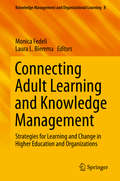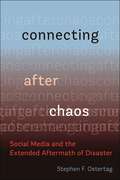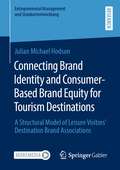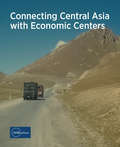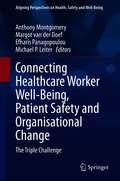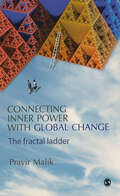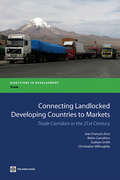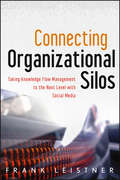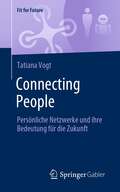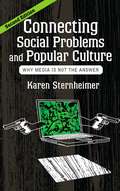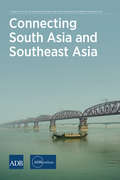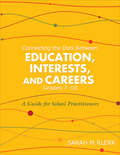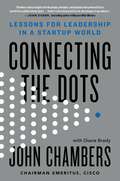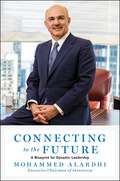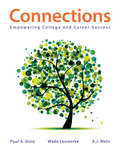- Table View
- List View
Connecting Adult Learning and Knowledge Management: Strategies for Learning and Change in Higher Education and Organizations (Knowledge Management and Organizational Learning #8)
by Laura L. Bierema Monica FedeliThis multidisciplinary book represents an initial attempt to connect adult learning and knowledge management in theory and practice. It provides educators, learners and organizational development professionals with new strategies and resources for developing active and effective pedagogies, which in turn prepare learners and practitioners to manage knowledge in organizations and higher education. To do so, it gathers contributions and case studies from a diverse, global team of authors and provides a theoretical and practical outline of new strategies and methods for facilitating adult teaching and learning. It also provides a fresh reading of active learning methods, by adopting a knowledge management viewpoint that is broadly applicable, whether helping students master content in university courses, or helping organizations learn and change.The book is divided into three main sections: a) methods and theories for adult teaching and learning; b) knowledge management in education; and c) case studies and best practices that consider classroom learning, higher education change, and organization development.
Connecting After Chaos: Social Media and the Extended Aftermath of Disaster
by Stephen F. OstertagA riveting portrait of how one community used the power of culture to restore their lives and socialconnections in the years after a devastating natural disasterNatural disasters and other such catastrophes typically attract large-scale media attention and public concern in their immediate aftermath. However, rebuilding efforts can take years or even decades, and communities are often left to repair physical and psychological damage on their own once public sympathy fades away. Connecting After Chaos tells the story of how people restored their lives and society in the months and years after disaster, focusing on how New Orleanians used social media to cope with trauma following Hurricane Katrina.Stephen F. Ostertag draws on almost a decade of research to create a vivid portrait of life in “settling times,” a term he defines as a distinct social condition of prolonged insecurity and uncertainty after disasters. He portrays this precarious state through the story of how a group of strangers began blogging in the wake of Katrina, and how they used those blogs to put their lives and their city back together. In the face of institutional failure, weak authority figures, and an abundance of chaos, the people of New Orleans used social media to gain information, foster camaraderie, build support networks, advocate for and against proposed policies, and cope with trauma. In the efforts of these bloggers, Ostertag finds evidence of the capacity of this and other forms of cultural work to motivate, guide, and energize collective action aimed at weathering the constant instability of extended recovery periods. Connecting After Chaos is both a compelling story of a community in crisis and a broader argument for the power of social media and cultural cooperation to create order when chaos abounds.
Connecting Brand Identity and Consumer-Based Brand Equity for Tourism Destinations: A Structural Model of Leisure Visitors’ Destination Brand Associations (Entrepreneurial Management und Standortentwicklung)
by Julian Michael HodsonThe study proposes and empirically validates an integrated model of leisure visitors’ destination brand associations that can guide destination marketing and branding activities for both, the brand identity and the consumer-based brand equity (CBBE) perspective. A ten-phase empirical research design is established and data is collected from a sample of German leisure visitors to the Balearic Island of Mallorca, Spain. Structural equation modeling (SEM) provides empirical evidence of construct validity and reveals strong support for the validity of the proposed structural theory of leisure visitors’ destination brand associations. Results also demonstrate that the structural model possesses excellent levels of predictive power and validity. Importantly, the model performs very well in the overall prediction of consumers’ destination brand attitudes and loyalty.
Connecting Central Asia with Economic Centers
by AdbiThis is the final report of the Asian Development Bank Institute study Connecting Central Asia with Economic Centers. The study focuses on the five Central Asian economies: Kazakhstan, the Kyrgyz Republic, Tajikistan, Turkmenistan, and Uzbekistan.The aim of the study is to examine the pattern of economic relations between these economies and major economic centers since Central Asia began its transition to a market economy in the early 1990s, highlighting emerging challenges and exploring their policy implications along the way. The report considers trade ties, foreign direct investment and financial flows, migration and remittances, and institutional cooperation between the Central Asian economies and major economic centers such as those in Asia, the European Union, the Russian Federation, and the United States.
Connecting Flights
by Lou BarrettIn this gathering of poems, award-winning poet Lou Barrett connects childhood with youth, youth with maturity, maturity with age and wisdom. She connects generation with generation, past with present, present with future, person with person. No poet embraces life more openly, more passionately, more intensely. Lou Barrett is a writer of intimacy and intoxication and wonders and splendors. "Connecting Flights" is a book to read again and again.
Connecting Healthcare Worker Well-Being, Patient Safety and Organisational Change: The Triple Challenge (Aligning Perspectives on Health, Safety and Well-Being)
by Michael P. Leiter Anthony Montgomery Efharis Panagopoulou Margot van der DoefThis volume delineates the ways in which key areas of healthcare, well-being, patient safety and organisational change overlap with and contribute to unhealthy workplaces for healthcare professionals. There is a growing realisation within healthcare that healthcare worker well-being, patient outcomes and organisational change are symbiotically linked. Burnout and stress in healthcare workers and toxic organisational cultures can lead to a cycle of patient neglect, medical errors, sub-optimal care and further stress. This topical volume therefore outlines the ways in which worker well-being, patient outcomes and organisational change can be aligned to contribute to a healthy workplace and therefore better medical care. The volume includes an array of authors from different disciplines including primary care, clinical medicine, psychology, sociology, management, clinical governance, health policy and health services research. It succeeds in integrating different voices and reaches meaningful conclusions to address the challenges facing the healthcare workforce.
Connecting Histories in Afghanistan: Market Relations and State Formation on a Colonial Frontier
by Shah Mahmoud HanifiThis discussion of colonialism in nineteenth century Afghanistan examines the economic development of the urban centers of Kabul, Peshawar and Qandahar and their relations among themselves and the surrounding rural countryside. Hanifi, a professor of history at James Madison University, argues that the seeming independence of Afghanistan from British colonial control, embodied in the defeat of English military incursions in the 1840s and 1870s, was in fact an illusion, and that economic imperialism in the form of market ties with British India represented some measure of de facto colonial control. The work includes several tables and numerous black and white photographs and reproductions of historical illustrations and documents. Annotation ©2011 Book News, Inc. , Portland, OR (booknews. com)
Connecting Inner Power with Global Change: The Fractal Ladder (Response Books)
by Pravir MalikThe power to change things lies within us. Presented in this book is a theory of how shifts in oneself can have profound shifts in corporations, markets, systems and the world. It has been said, ′Become the change you wish to see in the World.′ But the elaboration of how this is true may remain a mystery. The theory of organization introduced in this book indicates a fractal reality in which an idea, a person, a team, a corporation, a market, a system, and progressively more complex constructs are concretely connected by virtue of common and linked patterns that animates each of these separate levels. Hence the power to positively change progressively more complex and removed arenas of life by making corresponding changes in one′s personal space becomes more real. The fractal theory introduced in this book indicates how these complex structures can be holistically perceived and correspondingly shifted. It presents the ideas through reader-friendly figures and tables for better understanding. It will be an invaluable resource for professionals working in the fields of business and management.
Connecting Landlocked Developing Countries to Markets
by Graham Smith Jean-François Arvis Robin Carruthers Christopher WilloughbyThis book aims to help the policymaker and development community in general to understand the nature of the problems and policy dilemmas that landlocked countries face to trade with the rest of the World. This volume presents an important breakthrough in the literature, by focusing on a new conceptual framework that challenges the previous paradigm based on physical infrastructure and state-led access solutions, embodied in many treaties. By recognizing that the main access problems for landlocked countries occur in the territory of the transit country, this volume provides a new approach to understand the set of incentives that drive the political economy and shape the institutions governing goods' transit along corridors. Overall, the policy levers available to overcome these barriers are based on universally applied principles, recognizing the need for re-engineering current transit regimes which have been implemented with little success outside Europe. A risk-approach to border control and technology use, along with trust building between private operators and public agencies, all point toward the need to encourage and formally recognize higher-quality trucking companies. Meanwhile, other modes of transportation represent an alternative to road transit, but they also entail disadvantages, suggesting that their role is likely to remain limited to niche segments, specific commodities and exceptional market circumstances.
Connecting Leadership Attributes to Results
by Dave Ulrich Norm Smallwood Jack ZengerPeople often associate effective leadership with certain leadership attributes, but leadership capability must be put to appropriate, purposeful use. This chapter describes the perils of developing leadership attributes only, without connecting these attributes to results.
Connecting Organizational Silos: Taking Knowledge Flow Management to the Next Level with Social Media (Wiley and SAS Business Series #61)
by Frank LeistnerPractical guidance on how to successfully introduce enterprise social networks to connect employees While there are a fast growing number of books around social media and enterprise 2.0, the focus is often on the technical tools. Connecting Organizational Silos approaches social media and enterprise 2.0 from a knowledge flow management perspective. It offers practical and specific guidance on what to do and what not to do when introducing social media in an organization. This concise, easy-to-read guide offers a nuts-and-bolts look at how to get started in social media and drive it to success. Examines knowledge flows and the deployment of social media networks within organizations Helps organizations become more successful in introducing social media tools and platforms into their organizations By incorporating social media into their business, organizations will be able to make better use of their member's knowledge and thereby become more competitive. Connecting Organizational Silos discusses all aspects of enterprise social media and how it can help to drive corporate growth.
Connecting People: Persönliche Netzwerke und ihre Bedeutung für die Zukunft (Fit for Future)
by Tatiana VogtNetzwerken ist so alt wie die Menschheit selbst. Es schenkt uns Verbindung, ein Gefühl von Zusammengehörigkeit, schafft einen sozialen und gesellschaftlichen Rahmen, der unser Gefüge zusammenhält und das eigene Überleben sichert. Das Zusammenwirken fördert unsere Entwicklung und schafft einen Verbund und Austausch von Interessen, in allen Bereichen unseres Lebens. Der Mensch ist nun einmal ein soziales Wesen, das Nähe, Kontakt, Austausch sucht und braucht. Doch wie netzwerkt man miteinander, gerade in einer sich stetig wandelnden Welt? Im Zeitalter der Digitalisierung werden persönliche Kontakte immer seltener und rücken in den Hintergrund. Roboter Netzwerke entstehen und ersetzen in vielen Fällen berufsbedingt den Menschen. Doch gerade hier liegt auch eine Chance, denn durch das aktive Netzwerken können sich Menschen im beruflichen und privaten Kontext von der Maschine abheben.
Connecting Social Problems and Popular Culture
by Karen SternheimerIs violence on the streets caused by violence in video games? Does cyber-bullying lead to an increase in suicide rates? Are teens promiscuous because of Teen Mom? As Karen Sternheimer clearly demonstrates, popular culture is an easy scapegoat for many of society’s problems, but it is almost always the wrong answer. Now in its second edition, Connecting Social Problems and Popular Culture goes beyond the news-grabbing headlines claiming that popular culture is public enemy number one to consider what really causes the social problems we are most concerned about. The sobering fact is that a "media made them do it" explanation fails to illuminate the roots of social problems like poverty, violence, and environmental degradation. Sternheimer’s analysis deftly illustrates how welfare "reform," a two-tiered health care system, and other difficult systemic issues have far more to do with our contemporary social problems than Grand Theft Auto or Facebook. The fully-revised new edition features recent moral panics--think sexting and cyberbullying--and an entirely new chapter exploring social media. Expanded discussion of how we understand society’s problems as social constructions without disregarding empirical evidence, as well as the cultural and structural issues underlying those ills, allows students to stretch their sociological imaginations.
Connecting South Asia and Southeast Asia
by AdbiThis report analyzes how closer regional connectivity and economic integration between South Asia and Southeast Asia can benefit both regions, with a focus on the role played by infrastructure and public policies in facilitating this process. It examines major developments in South Asian-Southeast Asian trade and investment, economic cooperation, the role of economic corridors, and regional cooperation initiatives. In particular, it identifies significant opportunities for strengthening these integration efforts as a result of the recent opening up of Myanmar in political, economic, and financial terms. This is particularly the case for land-based transportation-highways and railroads-and energy trading. The report's focus is on connectivity in a broad sense, covering both hardware and software, including investment in infrastructure, energy trading, trade facilitation, investment financing, and support for national and regional policies.
Connecting the Dots Between Education, Interests, and Careers, Grades 7–10: A Guide for School Practitioners
by Sarah M. KlerkThese ready-to-use lessons generate deep discussion about life after graduation and get students ready for college or career. Includes conversation starters, quizzes, reflections, and up-to-date career information.
Connecting the Dots: Lessons for Leadership in a Startup World
by Diane Brady John ChambersSilicon Valley visionary John Chambers shares the lessons that transformed a dyslexic kid from West Virginia into one of the world's best business leaders and turned a simple router company into a global tech titan. When Chambers joined Cisco in 1991, it was a company with 400 employees, a single product, and about $70 million in revenue. When he stepped down as CEO in 2015, he left a $47 billion tech giant that was the backbone of the internet and a leader in areas from cybersecurity to data center convergence. Along the way, he had acquired 180 companies and turned more than 10,000 employees into millionaires. Widely recognized as an innovator, an industry leader, and one of the world's best CEOs, Chambers has outlasted and outmaneuvered practically every rival that ever tried to take Cisco on--Nortel, Lucent, Alcatel, IBM, Dell, and Hewlett-Packard, to name a few. Now Chambers is sharing his unique strategies for winning in a digital world. From his early lessons and struggles with dyslexia in West Virginia to his bold bets and battles with some of the biggest names in tech, Chambers gives readers a playbook on how to act before the market shifts, tap customers for strategy, partner for growth, build teams, and disrupt themselves. He also adapted those lessons to transform government, helping global leaders like French President Emmanuel Macron and Indian Prime Minister Narendra Modi to create new models for growth. As CEO of JC2 Ventures, he's now investing in a new generation of game-changing startups by helping founders become great leaders and scale their companies. Connecting the Dots is destined to become a business classic, providing hard-won insights and critical tools to thrive during the accelerating disruption of the digital age.
Connecting the Nineteenth-Century World: The Telegraph and Globalization
by Roland WenzlhuemerBy the end of the nineteenth century the global telegraph network had connected all continents and brought distant people into direct communication 'at the speed of thought' for the first time. Roland Wenzlhuemer here examines the links between the development of the telegraph and the paths of globalization, and the ways in which global spaces were transformed by this technological advance. His groundbreaking approach combines cultural studies with social science methodology, including evidence based on historical GIS mapping, to shed new light on both the structural conditions of the global telegraph network and the historical agency of its users. The book reveals what it meant for people to be telegraphically connected or unconnected, how people engaged with the technology, how the use of telegraphy affected communication itself and, ultimately, whether faster communication alone can explain the central role that telegraphy occupied in nineteenth-century globalization.
Connecting to Change the World: Harnessing the Power of Networks for Social Impact
by John Cleveland Madeleine Taylor Peter PlastrikSomething new and important is afoot. Nonprofit and philanthropic organizations are under increasing pressure to do more and to do better to increase and improve productivity with fewer resources. Social entrepreneurs, community-minded leaders, nonprofit organizations, and philanthropists now recognize that to achieve greater impact they must adopt a network-centric approach to solving difficult problems. Building networks of like-minded organizations and people offers them a way to weave together and create strong alliances that get better leverage, performance, and results than any single organization is able to do. While the advantages of such networks are clear, there are few resources that offer easily understandable, field-tested information on how to form and manage social-impact networks. Drawn from the authors' deep experience with more than thirty successful network projects, Connecting to Change the World provides the frameworks, practical advice, case studies, and expert knowledge needed to build better performing networks. Readers will gain greater confidence and ability to anticipate challenges and opportunities. Easily understandable and full of actionable advice, Connecting to Change the World is an informative guide to creating collaborative solutions to tackle the most difficult challenges society faces.
Connecting to the Future: A Blueprint for Dynamic Leadership
by Mohammed AlardhiA comprehensive, step-by-step guide to creating a forward-thinking blueprint for dynamic company growth from executive chairman of the internationally renowned wealth management firm Investcorp, Mohammed Alardhi.In 2015, when Mohammad Alardhi became the executive chairman of Investcorp, a leading global manager of alternative investments, he arrived with a transformative mindset that would set the company on a path to unprecedented growth. Within three years of Alardhi taking control of the company, their wealth management grew from $10B to $25B, and three years after that, it had grown to a remarkable $42B. After seven years under Alardhi&’s leadership, Investcorp was managing an astounding $50B in wealth. In Connecting to the Future, Alardhi speaks candidly about the big thinking needed to succeed at such a large scale. From setting bold goals for your organization to questioning the status quo to recognizing that your greatest asset will always be a motivated and passionate team, he walks you through his blueprint not just for growth but for leadership, awareness, and fundamental change. The challenge Alardhi describes in Connecting to the Future is familiar to every business leader: adapt or die. But Alardhi also answers the perennial question of how to not just succeed, but to exceed expectations on your way to continually redefining your company&’s strength.
Connecting with China
by Joan TurleyIf you are prepared to connect with China, it will make all the difference. Joan Turley provides all the signposts and insights to help those working with China understand the value of relationships and the importance of people as the key elements in making business and everything else work. This extremely powerful book will unlock your ability to build working relationships with China, for mutual success. "The book provides an invaluable reference for all businesses with any current or future interest of building a successful relationship with China. This is a topic that is as complicated and diffuse as the Chinese language itself and a reference such as this can save both time and money. " -David Paice, Marketing Manager, Cathay Pacific "Joan Turley's deep and delicate observation is really refreshing and practical and her understanding about China goes beyond my expectations. I believe Ms. Turley's new book will not only be welcomed by the British people but the Chinese people as well. " -Dizun Chen, Director of the General Office, Liaoning Provincial Party Committee "Joan Turley has great insight as well as ability to interpret different cultures for each other. Her knowledge is thorough as she has both academic and practical business experience of China. Her book has relevance both to the West and to China. " -Mr Huo, President, North Media "An indispensable handbook for developing successful UK/China business relationships. For an industry which thrives on ideas which turn customer understanding into commercial or social advantage, Joan's insights into Chinese culture and thinking are both instructive and relevant. " -Janet Hull, Consultant Head, Marketing and Reputation Management, IPA "The chapter on Law and Successful Relationships in China is a must for any lawyer wanting to do business in that part of the world. " -Eifion Morris, Partner, Stephenson Harwood, Law Firm of the Year 2009 "An authoritative and informative insight into conducting business in China, from an original standpoint that gives practical advice to both those with existing business and those approaching the Chinese market for the first time. " -Philip Moore, Asia-Pacific Manager, Andor Plc "Turley has taken her vast experience in working closely with Chinese companies, government and individuals to deliver robust advice on developing strategic and long term business relationships through communication, relationship development and sound planning and research. " -Barry Allaway, Managing Director, Worldwide Magazine Distribution Joan Turley has enormous understanding working successfully with China. Pivotal to her success is the understanding that connectivity is the key to building relationships, and it is this that will ultimately determine your success in business culture. Connecting with China aims to facilitate a smooth path for all those at the brink of working with China, or who are already involved but need further guidance. Understanding the forces that shape Chinese strategic thinking will only partially assist you in progressing up the very formal hierarchy which the Chinese use to codify relationships and signal degrees of trust and the will to cooperate. Full of insights, tools, techniques and tips this book provides invaluable lessons on how to build relationships, and how to channel Western skills into Chinese ways of working.
Connecting with and Engaging Customers: Strategies for Realizing Customer Advantage
by Erich JoachimsthalerA company cannot create customer advantage until it first connects with and engages consumers. Understanding the relationships consumers have with your organization will better enable you to grow in new markets, reinvent your business model, expand into adjacent markets, and build new demand-first growth platforms.
Connection: How the Need to Relate to Oneself and Others Affects Consumer Thinking
by Gerald Zaltman Lindsay ZaltmanHumans have a basic need for affiliation. The need to relate to others and to oneself has established connection as a major and pervasive lens through which consumers view the world.
Connections
by Paul A. Gore Wade Leuwerke A. J. MetzAre you looking for a college success resource that speaks to the all aspects of a student's college experience? Connections is an innovative new text that offers the ideal balance of motivation, academics, and life skills. It starts with comprehensive coverage of the topics typically covered in the introductory course but has a unique emphasis on goal-setting, life skills and career planning. When packaged with LaunchPad for Connections, it integrates a state-of-the-art, norm-referenced, student-self assessment of non-cognitive and cognitive skills tool called ACES. Print and digital are uniquely combined for a personalized experience. In every chapter, students are encouraged to take a positive, success-oriented approach to this course - and to life in general - by working to strengthen their strengths, celebrate progress, and use setbacks as opportunities for growth. With an emphasis on self-knowledge, and on building skills for college and career success, Connections empowers students to become self-regulated, collaborative learners - learners who thrive in school, on the job, and in the community.
